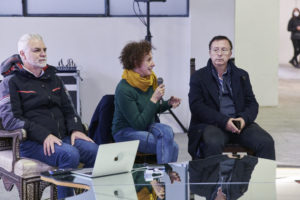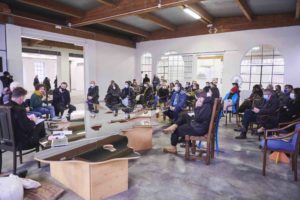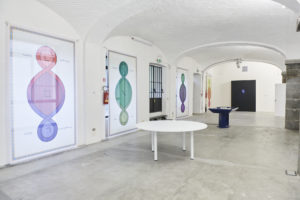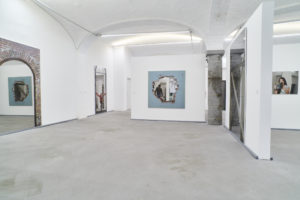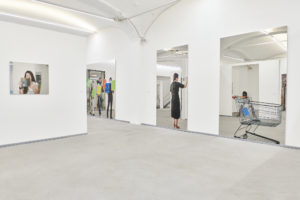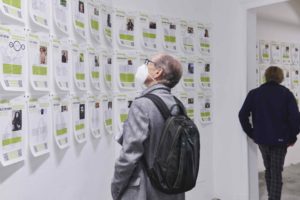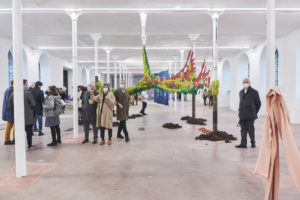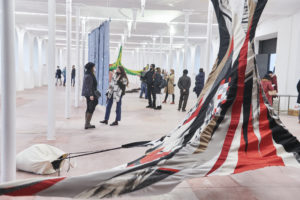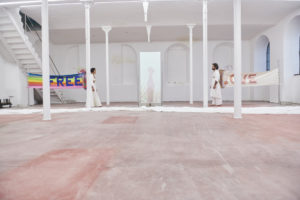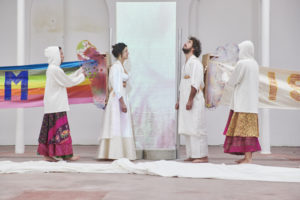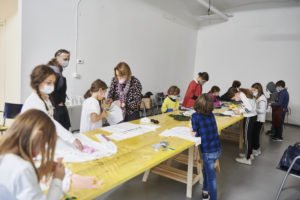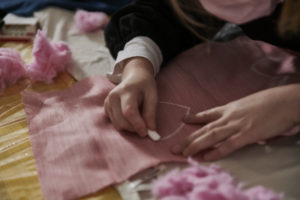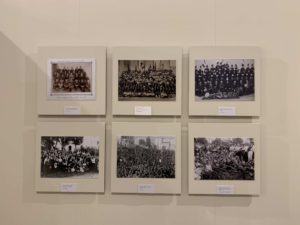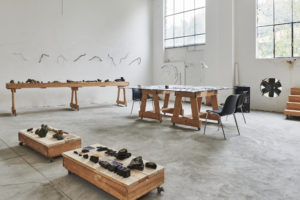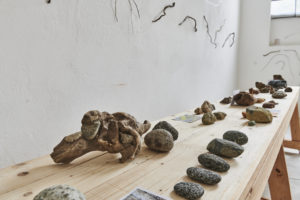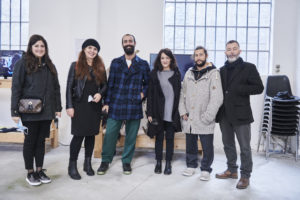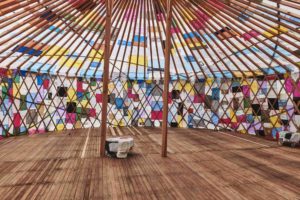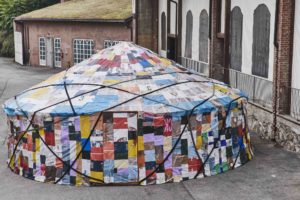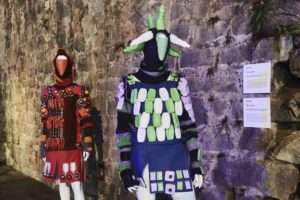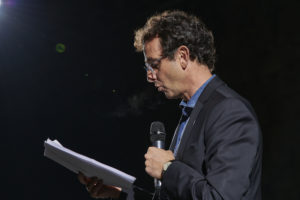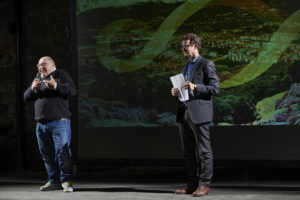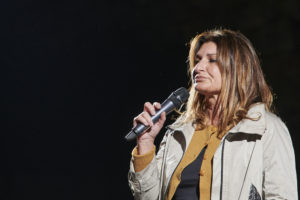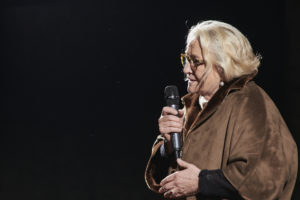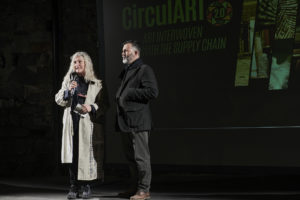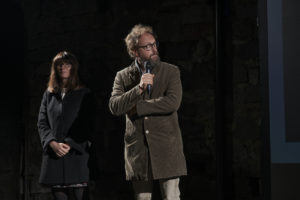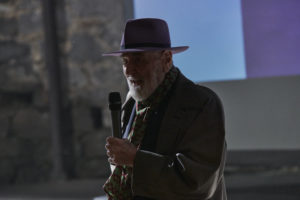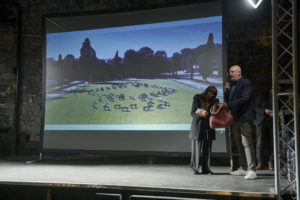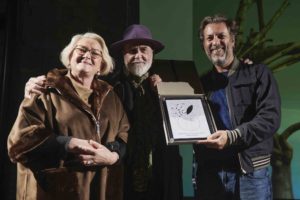It was 30th October 2019 when Biella became part of the UNESCO Creative Cities Network in the Crafts and Folk Art category. Two years after that prestigious designation, the city has experienced a new iconic day, not only celebratory, but demonstrative of all the best practices and realities that characterise and animate the wool territory. The reference is to the 23rd edition of Arte al Centro (Art at the Centre), a not accidental connection, in light of the fact that this year’s exhibition event was combined with Arcipelago, Festival of Sustainable Creativity, placing art at the centre of Biella and the Biellese, declining the UNESCO designation along the path drawn by the symbol of the Third Paradise: creativity and responsibility. Last Saturday’s event, as reported in a previous article, proposed new exhibitions intended as activity devices open to the collaboration of different subjects – as well as for the enjoyment of visitors – and highlighted artistic practices of transformation of the social contexts in which they develop, carried out by Cittadellarte and the international network it has consolidated over the years. The event was a success with the public despite the gloomy autumn day, with a heterogeneity of participants in terms of both provenance and age.
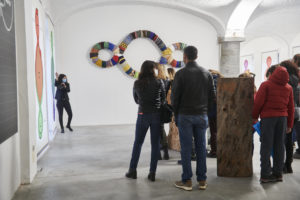
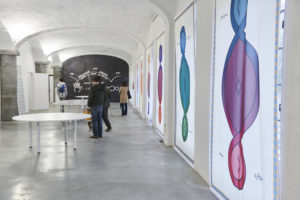
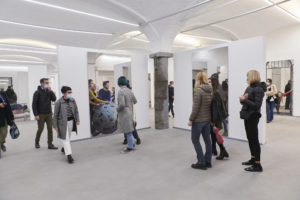
Guided tours.
An exhibition of Biella’s best practices
One of the highlights of the event was Biella Città Arcipelago – Sustainability and creativity in the Biella area*(curated by Cittadellarte, Art and Politics Office – coordinator Paolo Naldini, collaborators Elisa Gilardino and Andrea Trivero): a territorial workshop exhibition that recounts a year of mapping that seven youth associations, led by Cittadellarte, carried out during the pandemic and lockdown. “More than 100 case studies, active subjects on one or more goals of the United Nations 2030 Agenda for Sustainable Development, – reads the curatorial text – convey the vision of the Biella area as an ‘archipelago of good practices and vitality’, from the textile sector to hospitality and tourism, from the agrifood chain to waste management and common good resources such as water and energy, from education to mobility. The Biella Città Arcipelago workshop and exhibition, which is being developed in synergy with the BIellezza Foundation and in conjunction with local institutions, is an open space for citizens’ participation: organisations from all sectors are invited to propose themselves in order to take part not only in the exhibition, but also in the programme that is currently being defined and that will follow it, consisting of thematic meetings on the various sectors, in collaboration with the various tables already active in the Biella area, oriented towards agreeing on and implementing concrete actions towards sustainable prosperity”. In short, the exhibition reflects the macrocosm of initiatives, organisations, associations and good practices that are present and active in the Biella area. A living exhibition project, which does not just show the excellence of each sector of the social fabric of Biella and its province, but acts as a starting point for offering new inputs and new thoughts for networking and drawing attention to new responsible practices. It is therefore an interactive exhibition that invites the spectator to make their own contribution: in its spaces, as an integral part of the project, there are blackboards on which visitors can write or mention relevant ideas and projects. The exhibition is designed to last and grow over time: it is a laboratory in progress, a continuously updated device that, even after its opening, will keep including other actors active in sustainability, allowing visitors to always discover new and updated data and stories.“The exhibition is not an arrival point, but the start of a real participatory project shared with mapped and unmapped subjects. The workshop will develop through thematic groups/workshops on the priorities emerging from the mapping: energy and decarbonisation, the textile industry and sustainable fashion, slow tourism and hospitality, the educating community, natural and seasonal food chains, clean water, waste and circular economy, sustainable mobility and responsible digital communication. This phase of the project – called Forum Biella Città Arcipelago – invites all local organisations to actively participate in the rebirth of the Biella area towards a sustainable prosperity”.
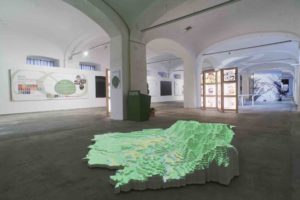
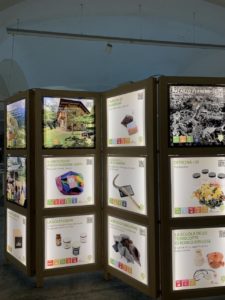
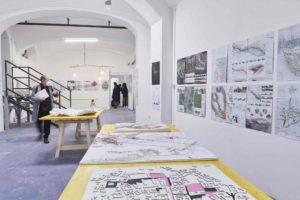
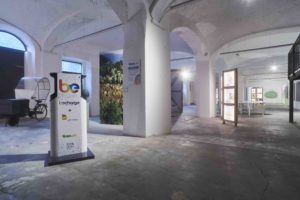
The exhibition Biella Città Arcipelago – Sustainability and creativity in the Biellese territory.
Film works
Arte al Centro proposed a plurality of expressive languages among which videos played a key role. In fact, on show were the works of the winners of Sustainable views – different perspectives, a competition curated by the If Collective aimed at enhancing artistic production dedicated to the moving image that uses new technologies as new creative possibilities and to raise awareness on the theme of sustainability: Against the Tide by Riccardo Grando and Giacomo Graziano; Bottlefield by Marta Ciolkoswka and Overlayed Symbiosis by Giovanni Chiamenti.
In addition to the entries to the call, Arte al Centro screened L’uomo degli alberi (The Man of the Trees), a film by Andrea Trivero that tells the story of Daniel Balima, an elderly horticulturist from Tenkodogo, who, despite growing up without the use of his legs, has managed to follow his father in running the family tree nursery, walking on his hands. A profound, impactful story of resilience that makes the viewer reflect and sympathise. “Daniel immediately started working with huge passion and talent, – reads the film’s synopsis – so much so that Daniel saw his disability, which in Africa for many means a doomed future, as an opportunity: ‘I had two options: either begging or taking my life into my hands and dedicating myself to work with dignity’. Daniel has chosen and won this enormous challenge and, every day, he sows and farms a great quantity of vegetables and plants for his family and friends with great effort and gratitude”. The exhibition also gave ample space to Over Time, a video project by artist Laura Pugno that won the 9th edition of Italian Council (2020), a programme for the international promotion of Italian art of the General Directorate of Contemporary Creativity of the Ministry of Culture. It is a three-channel video work that explores the relationship between human beings and the natural environment, which has always been at the heart of Laura Pugno’s research, through her gaze on snow, a material that is both powerful and vulnerable, and affects climates, living systems and economies. “The project develops the investigation on snow I started in 2018, – explained the artist –conducted in the different languages of drawing, sculpture, photography, installation and in a cycle of works on paper dedicated to Wilson Bentley, the photographer who was the first to immortalise snowflakes at the end of the nineteenth century, conveying in images the fascination exerted by the uniqueness of those ‘tiny miracles of beauty’ that rain from the sky”. The film, shown on three big screens, is able to propel the spectator into the snowy mountains: sounds, images and specially edited filming make the viewers feel the white-coloured cold on their skin. The programme then proposed the talk Tutta colpa dei neuroni specchio (It’s all the mirror neurons’ fault), in which Grammenos Mastrojeni (diplomat and lecturer in Environment and Geostrategy) and Giuseppe Barbiero (lecturer in Biology and Ecopsychology at the University of Valle D’Aosta) opened a debate with the artist Laura Pugno and the curator Andrea Lerda in the wake of the images of the work Over Time.
The talk Tutta colpa dei neuroni specchio.
The novelties of Cittadellarte
The Universario, which occupies the entire space of Cittadellarte’s “column room”, is dedicated to the formula of trinamics, and includes the classrooms of the Unidee Academy of Fine Arts. The name of the Academy, Unidee, comes from a long programme of activities started in 1998, with Unidee – University of Ideas. The term ‘university’ was intended as ‘universality’. Now the space that houses the Academy is called Universario, and is totally dedicated to creation as a universal phenomenon. This place is designed not only to educate students but also to educate society, starting with the visitors. Touring the Universario is like visiting a scientific research centre totally focused on art, illustrating the most advanced discoveries leading to the formula of creation. The processes of research and discovery are presented through the display and a multimedia table designed and built by the CNR (National Research Centre). Pistoletto’s most recent Mirror Paintings, from 2019 to 2021, were presented to the public for the first time in the space housing the permanent exhibition of his mirror works. Among the new openings was the exhibition The Art of Balance/Pandemopraxy, curated by Francesco Saverio Teruzzi and Luca Deias: an appeal, 100 authors, 2 special interviews with Michelangelo Pistoletto and Carlo Ratti, and “almost a manifesto” drawn up at the time of the Coronavirus by Paolo Naldini. A year-long adventure that, in the midst of the pandemic, searched for, investigated and proposed possible alternative futures for the post-Covid era. The project highlights a story through the images, incipits of articles and videos of a column in Cittadellarte’s Journal that featured, in discontinuous waves of contributions, ambassadors of the Third Paradise, architects, artists, actors, singers, chefs, designers, teachers, members of institutions, politicians, professionals from the world of art and fashion, students and guests from every sector of the social fabric. The permanent home of the Third Paradise also hosted the exhibition Objects of the Third Paradise with the following works: Homage to Michelangelo Pistoletto (mirrors, iron tubing and sheet metal scraps, 200 x 300 x 200), by Sebastiano Pelli, Davide Carnevale and Francesco Saverio Teruzzi, 2019; Third, Reflected, by Alessandro Lista, 2015; an installation – created in collaboration with Vimar 1991 – consisting in a suspended Third Paradise made by dropping yarn from the Biella-based company; the first of the Third Paradise canvases of the project Kids Guernica, curated by Savina Tarsitano, Takuya Kaneda and Francesco Saverio Teruzzi; a mirror – curated by Giorgio de Finis – supporting a Third Paradise in black film with the signatures of the participants in the Rebirth Day held at Macro Asilo on 21st December 2019. The same space in Via Cernaia also exhibited the winning works of the illustration competition organised by Embajada Rebirth / Tercer Paraíso in Cuba and Galleria Continua in Havana.
In the pictures: Universario (1, 2); Mirror Paintings (3, 4); the exhibition The Art of Balance / Pandemopraxy (5, 6).
Sustainable fashion
CirculART, presented on the occasion of Arte al Centro, is a project curated and produced by Cittadellarte that brings together companies, artists and fashion designers to give life to new forms of language capable of inspiring change. The encounter and integration of two apparently distant and different dimensions can only generate unexpected, innovative and potentially improving results compared to a status quo that is no longer sustainable. This is why Cittadellarte – Fondazione Pistoletto launches the second edition of CirculART: CirculART II – Art Interwoven with the Supply Chain, a project for social renewal, the result of a path to integration and inclusion between the worlds of art and industry, which takes shape in an exhibition that opens on the occasion of Arte al Centro in the spaces of Cittadellarte’s restored industrial archaeology. In line with this perspective, companies and artists will tell, through the works they have created for the project, how we can be aware innovators producing concrete elements of social resilience and drawing inspiration from the current needs of the ecosystem in which the new humanity is developing. CirculART II involves four artists – Silvia Giovanardi, Ryts Monet, Giulia Pellegrini and Marcello Pipitone – and thirteen textile companies of excellence with which they have been called to enter into a dialogue. The pure and unprecedented interpretation of industrial reality by the artists will serve to outline and reveal, through four original works of art, new design paradigms based on circular economy and ethics. Works created to inspire not only the textile industry, but all production sectors, to realign their enterprises with the ultimate promise of doing business: responding to humanity’s real needs. Partners of the initiative are: Cotonificio Albini SPA, Eurojersey SPA, Flainox srl, Filatura Astro srl, Lanificio F.lli Cerruti, Lenzing Group, Milior sas, Officina+39, Ribbontex srl, Taroni SPA, Tessuti di Sondrio, Tintoria Emiliana and Vimar 1991. By opening up to artistic research, they have given the four artists the opportunity to explore in an original way how the technologies, materials and processes they have developed to date can help inspire the drafting of a new chapter of the industrial revolution in progress, necessarily aimed at reconnecting and rebalancing with natural and social dimensions that have been exploited for too long. Aim of the project was also to push artistic research to deal with the different sectors that make up the textile supply chain, working with organisations that have chosen to embrace the idea of sustainability and to develop their business in an innovative and forward-looking way. In the context of the CirculART exhibition, one of the fashion designers involved in the project also presented Freedom, a romantic, emotional, intimate performance that recounted the moment in which the artist discovered and experienced intense moments of love and freedom. Lastly, the Re-wearing workshop (for 6- to 11-year-old children) offered a target group of very young people the chance to give new life to a piece of clothing that was no longer being worn, thus raising the participants’ awareness on the theme of recycling and circularity.
In the pictures: CirculART II (1, 2); Freedom (3, 4); Re-wearing (5, 6).
The younger generations
Schools are the beating heart of a community’s future. At Arte al Centro, Cittadellarte gave voice to the students not only through the mapping process of the exhibition Biella Città Arcipelago, but also through a display curated and produced by IIS “Eugenio Bona” Professional Course for Health and Social Work Services in collaboration with the artist and photographer Damiano Andreotti. The reference is to the project Alice oltre il lockdown (Alice beyond the lockdown), which is part of the Transversal Skills and Orientation opportunities that involved class G, from the fourth year up to the state examination, during the pandemic. “The experience correlated with distance learning and integrated digital teaching, with the artist carrying out interviews with the students and taking photos through virtual devices,” explained the teachers who followed the project, “to create a class story about their coexistence with the pandemic. The project then continued in the final year of their course of study with the production of texts for the exhibition, with the collaboration of their psychology teacher Arabella Debernardi, and a brochure, with the project coordination of their teacher Alberto Fontanella, who, as Rebirth/Third Paradise ambassador, supported the artistic and regenerative value of the project, which sees art also as a process and a cure for the soul. Andreotti then continued the emotional photographic investigation with some photos taken in presence after the students’ return to school. While the students were taking part in the photo shoot, Andreotti interviewed them, collecting not only their pictures but also their emotional reactions”. The result is impressive: on display are pairs of photographs showing close-ups of young people’s faces, with and without surgical masks. It is not difficult to read in the eyes, immortalised by those images and creating a striking expressive mosaic.
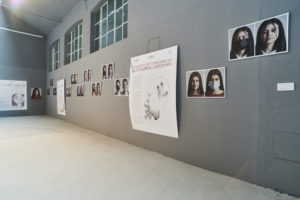
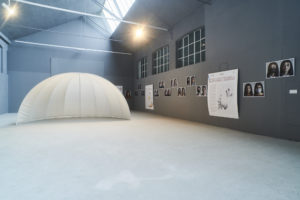
Alice oltre il lockdown.
The Biella area between work and food
The link with Biella also materialised through the two key contents of the themes of food and work. With regard to the latter, Arte al Centro hosted the new exhibition Da 120 anni con i lavoratori (120 years with the workers), curated by Luigi Spina (scientific director), Simonetta Vella, Brunello Livorno, Lorenzo Boffa Sandalina, Daniele Mason (texts and iconographic research), Pier Giorgio Clerici (video editing) and E20progetti (installation). The exhibition focuses on the history of the Biella Chamber of Labour and recounts the events that have had the greatest impact on society and on the living conditions of millions of Italian citizens at local, national and international levels since the beginning of the 20th century. Visitors were therefore offered the opportunity to immerse themselves into a one-hundred-and-twenty-year-long historical journey open to the future. The organisers explained: “This is not a self-celebratory event – a selfie – but a mirror in which we can recognise ourselves, from both a retrospective and a current perspective,”. Finally, the exhibition project gives space to the Contratto della Montagna (Mountain Contract), with the reconstruction of the events and protagonists of this important piece of Biellese history.
Let Eat Bi had set up an information point for the association, showcasing the products of excellence of its partners, and a pomology exhibition curated by Marco Maffeo, which was much appreciated, with countless posts on social networks published by visitors. A simple exhibition, ‘fruit of nature’, which however aroused the curiosity of those present, struck by the variety of apples on display. Food was also the key element in other moments of the event: mulled wine and chestnuts were served, while the dinner was pumpkin-based, in line with the principles of Let Eat Bi: eating local, natural and seasonal.
A few images of the exhibition Da 120 anni coi lavoratori and the pomology exhibition.
The theme of water and the open studio
Arte al Centro featured the Cervo Project Room, which presented a series of researches conducted in the last year by artists Annalisa Zegna and aaron inker on the river Cervo as a central element in the development of the Biellese territory, through a reflection on ecology, and on the relationship with the environment and between human and non-human. How can artistic practice and cultural action affect local imagination and the way the inhabitants relate with the river? The Cervo Project Room represents an archive in progress and the first phase of the project “Osservatorio sul Torrente” (Observatory on the river), an interdisciplinary research platform that focuses on the river as a common good and central element of the social, political, cultural and economic development of the Biella area. The Observatory was created to collect and promote interdisciplinary research and insights that question the relationship between the inhabitants and the river, and to stimulate new participatory experiences that highlight the less considered or forgotten aspects of the territory, with the aim of triggering the creation of other imaginaries and building a new collective narrative of people’s connection with the river. The event also featured an open studio curated by the artist Matteo Marchesi, with the mentorship of Federica Tardito and the assistance of Annalisa Zegna, which was a restitution of the research residency and the laboratory conducted in collaboration between Fondazione Piemonte dal Vivo, Cittadellarte – Fondazione Pistoletto and Spazio Hydro, developed within Fluviale. Art, environment and social research, a multidisciplinary programme dedicated to the river Cervo, the territory and its inhabitants. How can we build a collective place in which it is possible to manifest power without harming ourselves or others? What role do the frames and contexts in which we act play in manifesting a form of power? What happens and where does it lead to when a state of control is lost or abandoned? The research of Matteo Marchesi developed around these questions, with a group of eight youths between 15 and 20, in contact with a project called “Luria”, from the name of the folkloristic personification of the flood of the river Cervo. The open studio was an opportunity to share and compare the signs, memories and dynamics of this experience and this process, deeply intertwined with the body, with the topographical configuration of the river Cervo and with the organic and non-organic matter carried by it. The research laboratory was part of “CollaborAction kids – action of the Antibody Network XL”, dedicated to the dissemination of new works among the younger generations.
Images from the open studio (1, 2, 3); Nomade (4, 5); Corazze (Armours) by Enrica Borghi (6).
The opening
The opening started at 6 p.m. in Cittadellarte’s “tettoia” space, in the area where Enrica Borghi’s work Nomadehad been installed: a yurt, a place to stop, but also a place for meeting, exchange, conversation and debate on issues related to the circular economy, the environment and the problems of plastic disposal. The yurt has a wooden structure (based on the construction drawings of classic yurts) to which a roof has been added made of plastic waste material, a material which characterises Enrica Borghi’s works through her “stylistic sign”, from the bottles cut and assembled with geometric modules to the polyethylene bags sewn to compose chromatically appealing patchworks. The colours of the yurt and the scents of chestnuts and mulled wine were the background to the opening speech by Paolo Naldini. The director of Cittadellarte curated and personally held this vis-a-vis with the public, introducing guests, project curators and institutions. A series of contributions that in little more than an hour ‘restituted’ the key projects that Cittadellarte and its entire international network have been involved in. Michelangelo Pistoletto and Giuliana Carusi Setari, president of Cittadellarte, also spoke on the occasion. The other speeches were by politicians, such as the mayor of Biella Claudio Corradino and the councillor for UNESCO Barbara Greggio; by the managers and coordinators of the projects on show, that is Juan Sandovaland Olga Pirazzi for CirculART and Andrea Trivero and Elisa Gilardino for Biella Città Arcipelago; and key figures from the associations in the area, such as the president of Fondazione BIellezza Paolo Zegna.
Paolo Naldini (1); Claudio Corradino and Paolo Naldini (2); Barbara Greggio (3); Paolo Zegna (4); Giuliana Carusi Setari (5); Olga Pirazzi and Juan Sandoval (6); Elisa Gilardino and Andrea Trivero (7); Michelangelo Pistoletto (8); Saverio Teruzzi (9); Giuliana Carusi Setari, Michelangelo Pistoletto and Luigi Coppola (10).
At the end of the speeches, the Mimimum Prize** was officially awarded to Luigi Coppola, with the following motivation: “an artist, promoter of participatory projects and politically-motivated actions. After initial experiences in experimental theatre, he started activating long term processes inside groups and communities. Since 2013 Luigi has participated in establishing the cultural association and cooperative Casa delle Agriculture (House of Cultures and Agricultures) in Castiglione d’Otranto, southern Italy, a project which seeks to revive abandoned lands, repopulate the countryside, generate a sustainable economy and strengthen community cohesion. The collective organises the festival “Notte Verde: agriculture, utopie e comunità” with the aim of discussing themes such as biodiversity, circular economy and territorial sustainable models. Within this platform Luigi initiated the Scuola di Agriculture which combines agro-ecological learning with the artistic strategies of theatre, philosophy and music, and builds upon the participatory dynamics of the community of farmers, artists and activists. Another line of research and practice is connected with the idea of monetary commoning as a possible strategy to expand economic autonomy and politics of solidarity through the Common Wallet, an account shared between 11 people. His artistic practice is linked to a process of social reappropriation of the commons that starts with an analysis of specific social, political, and cultural contexts. In his investigative practice, Luigi aims at developing a method to unveil the mechanisms of artistic production within commoning processes. He’s experimenting with an approach able to intervene at all levels in the construction of the commons: starting from the first revelation of the latent state, through the activation of a shared social imaginary, to the symbolic translation of processes into visuals and narratives and the activation of the fundamental rituals and celebrations. He unfolds the grammar of co-creation uniting individuals to each other and to their communities of practice, their organisations, as fundamental components of societal fabric. He allows for a visible and impactful fulfilment of the minimum social dynamics at the basis of all human reality”. Closing the day was a concert by the student orchestra of the G. Cantelli Conservatory in Novara (pictured below), who performed two compositions written by the young students on the themes of the 2030 Agenda, and in particular in relation to young people and goals 4 and 8 and the dignity of education and work.
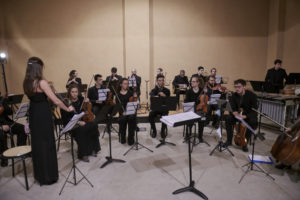
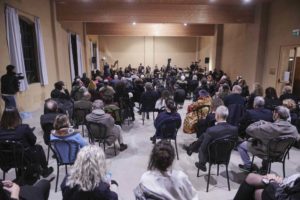
*The project saw the active participation of the following organisations: Fondazione BIellezza, in the context of the initiatives relating to Biella UNESCO Creative City; installation project by Fabrizio Lava in collaboration with Juan Sandoval; the technical and scientific contribution of Atelier Urban Design D (managed by Michele Cerruti But and Daniela Ciaffi, professors in the Master’s Degree Course in Architecture for Sustainable Design at Turin’s Polytechnic), of the Master’s Degree Course in Design, Creativity and Social Practices at Milan’s Polytechnic (managed by POLI.design and Accademia Unidee) and of the Province of Biella – Environmental Territorial Information System; the scientific advice of Fabio Porta; the map design advice of Sebastian von Stosch. The mapping was also carried out with the collaboration of Leo Club Biella, BI young, the Provincial Student Council, La Fenice, Biella Siamo Noi, Fridays For Future and Better Places. The curators of the exhibition would also like to thank for their contribution CNA, Confcooperative, Legacoop, Ascom, Confesercenti, Confartigianato, Unione Industriale Biellese, CTV Biella, the publishing house Emons Italia, the bookshop Ieri e Oggi, Tipografia Botalla, Associazione Ël Sol ëd J’Alp, E20Progetti.
**The Minimum Prize is a prize placed at the minimum level compared to the ones destined to big personalities who have dedicated their lives to the peace or the civil progress cause. The Minimum Price wants to be at the basis of the research, the incentive and the motive of a process aiming at the values of new civilization perspectives as an objective. It is a starting rather than an achievement award. It is an acknowledgement celebrating who promotes a responsible social transformation. It is meant as a primary relationship among people producing a big change in human civilization through the interaction of single units. Minimum like an embryo, like a principle generating a new society, like an access key to an evolutionary stage where creativity and human science find ways to live with the intelligence of nature.
Photo credits (unless otherwise specified): Damiano Andreotti.

